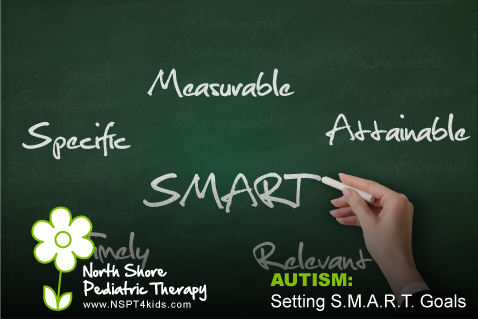Creating SMART Goals for Kids with Autism
When it comes to creating goals for kids with autism, it can be overwhelming where to start. What goal do you pick? When should they meet their goal? How can everyone work on it together?
Rest assured, creating effective goals is as simple as making sure it is a SMART goal: specific, measurable, attainable, relevant, and time-bound. Following these simple guidelines will help your child achieve the goals you set in place.
Specific
It is easy to have a general goal in mind for kids with autism, such as increasing their language or self-help skills. However, general goals are hard to work on since they do not have specific behaviors that you are looking to increase. Being as specific as possible with your goal is the most effective way to ensure your child will meet their goal.
Measurable
When we create a goal, we have to make sure we can measure a child’s success. If our goal isn’t measurable, we cannot accurately determine if the goal was met. The two most common ways to make goals measurable are frequency (e.g. 3 times per day, etc.) and accuracy (e.g. with 80% success, in 4 out of 5 opportunities, etc.).
Attainable
Before we start working on a goal, we have to make sure it is something the child can attain (i.e. a goal they can achieve). We need to look at prerequisite skills (i.e. skills the child needs in order to achieve the current goal). We also need to look at how realistic our goal is. We cannot expect a child to get dressed by themselves each morning if their underwear drawer is too high for them to reach.
Relevant
Relevant goals are goals that will make a difference in the child’s life. If the goal isn’t relevant to the child, the child will not be motivated to achieve it. If a goal is determined to not be relevant to the child or the one helping teach the goal, it will need to be adjusted to become relevant.
Time-bound
If all goals had an eternity to be achieved, there would not be a desire to teach and attain the goal in the near future. Making goals time-bound ensure that the goal is mastered in a realistic time-frame. Determining the time-frame of your goal should be dependent on the goal. The more challenging the goal, the longer the time-frame should be.
Example of a SMART Goal
Your goal is to work on your child asking you for help when you are in another room. At this time, your child does not ask you for help when you are in the same room consistently. Let’s go through each criterion to make our SMART goal.
Specific: Child will say “help me” while handing the object they need help with to the adult
Measurable: 4 out of 5 opportunities
Attainable: We will first work on when an adult is in the same room
Relevant: Your child frequently needs help when playing with new toys or opening and sealing food
Time-bound: 2 weeks
Now that you know how to write SMART goals, start making some and see your child blossom!



































